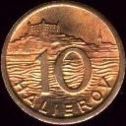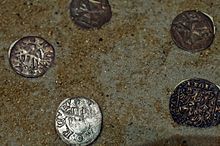Heller (coin)
| 10 Slovak hellers 1942 | |
|---|---|

| |
| Obverse | Reverse |
The Heller or Häller (German: [ˈhɛlɐ] ), a German coin originally valued at half a pfennig, took its name from the city of Hall am Kocher[1] (today Schwäbisch Hall).
Germany


Overview
Mints produced the coin from the beginning of the 13th century,[2] based on a previously produced silver pfennig (Häller Pfennig, sometimes called Händelheller for its depiction of a hand on the front face), but its composition deteriorated with the mixing in copper little by little so that it was no longer considered to be a silver coin. There were red, white and black Hellers. Beginning in the Middle Ages it became a symbol of low worth, and a common German byword is "keinen (roten) Heller wert", lit.: not worth a (red) Heller, or "not worth a red cent".
The term Heller came into wide use as a name for coins of small value throughout many of the German states up to 1873 when, after German unification, Bismarck's administration introduced the Mark and the pfennig as coinage throughout the German Empire.
History
In Swabia the Heller originally corresponded to the Pfennig, so that there were 240 Heller in a Charlemagne pound. However, by an imperial edict of 1385, the value of the Heller was halved, resulting in 8 Hellers = 4 Pfennigs = 1 Kreuzer and 4 Kreuzer = 1 Batzen[3]
Due to the low value and the non-standard quality of these coins, it was common in the High and Late Middle Ages to weigh large amounts of Hellers and to transact business based on the total coin weight; this often resulted in purchase amounts in "pound hellers", which did not necessarily correspond to the Charlemagne at 240 hellers.
In what was then Bohemian Upper Lusatia, the cities Bautzen and Görlitz had the right to mint coins. In the 15th century they coined alternately every year. The Görlitz Heller (Katterfinken) was a coin whose silver content decreased more and more in later years.
For example, around 1490, the House of Wettin's silver pfennig currency was: 24 hellers = 12 pfennigs = 2 half Schwertpfennigs = 1 Spitzpfennig = 1 Bartpfennig or Zinspfennig. The hellers were hollow and called Hohlhellers, similar to the Thuringian Hohlpfennigs.
In Electoral Saxony, low-value Besselpfennigs circulated as "invaders". They were referred to as Näpfchenheller in Saxon documents from 1668. In some areas of Saxony, for example in the Ore Mountains, they became a nuisance. The population preferred to throw the lower value Näpfchenhellers into the collection bag, which significantly reduced income from the collection. This led, for example, in Annaberg to the introduction of special church pfennigs (Kirchenpfennige).[4]
In the Electorate of Hesse, the silver groschen was divided into 12 hellers, so that the heller was equal to the Prussian pfennig. Dreiheller were copper 1½ pfennig pieces that were minted in Saxe-Gotha.
With the transition to a standard imperial currency of marks and pfennigs under the Coinage Act of 9 July 1873, the heller disappeared like all other old currency units (except for the simple Vereinstaler, which circulated until 1907). Only the last Bavarian Heller of the former guilder standard were still valid in Bavaria for a considerable time after 1878 as ½ pf coins of the new Goldmark imperial currency.
The German Heller saw a resurrection in 1904 when the government took over responsibility for the currency of German East Africa from the German East Africa Company. The Heller was introduced as 1/100 of a rupie instead of the pesa, which had been a 1/64 of a rupie up to that time.

In the 1920s the "Heller" currency was expanded to greater denominations in the German territories and printed bills were produced to represent their value for trade.
Austria-Hungary
In Austria-Hungary, Heller was also the term used in the Austrian half of the empire for 1/100 of the Austro-Hungarian krone (the other being fillér in the Hungarian half), the currency from 1892 until after the demise (1918) of the Empire.
Czechia
The term heller (Template:Lang-cs, Template:Lang-sk) was also used for a coin valued at 1/100 of a koruna (crown) in the Czech Republic (Czech koruna) and Slovakia (Slovak koruna), as well as in former Czechoslovakia (Czechoslovak koruna).
Only the currency of the Czech Republic continues to use Hellers (haléře), although they survive only as a means of calculation — the Czech National Bank removed the coins themselves from circulation in 2008 and notionally replaced them with rounding to the next koruna.
References
- ^ Escher (1881). Schweizerische Münz- und Geldgeschichte von den ältesten Zeiten bis zur Gegenwart (in German). Dalp. p. 105.
- ^ Revue suisse d'economie politique et de statistique (in German). 1877. p. 214.
- ^ For further details on the relationship between the different types of coins, see the article in the Schwäbisches Wörterbuch.
- ^ Kahnt (2005), p. 309.
See also
- Coins of the Czech koruna
- Coins of the Slovak koruna
- Czechoslovak koruna
- Bohemian-Moravian koruna
- Øre (Subdivision of Scandinavian crowns)
